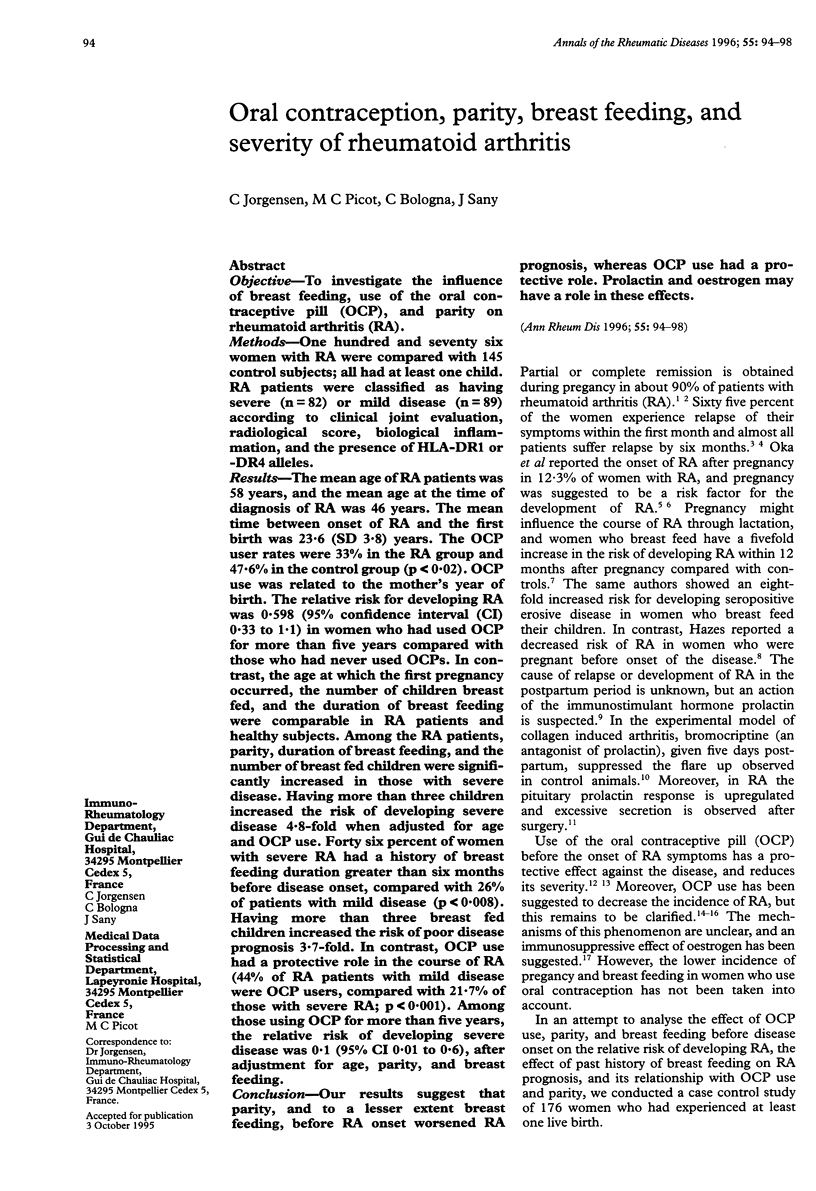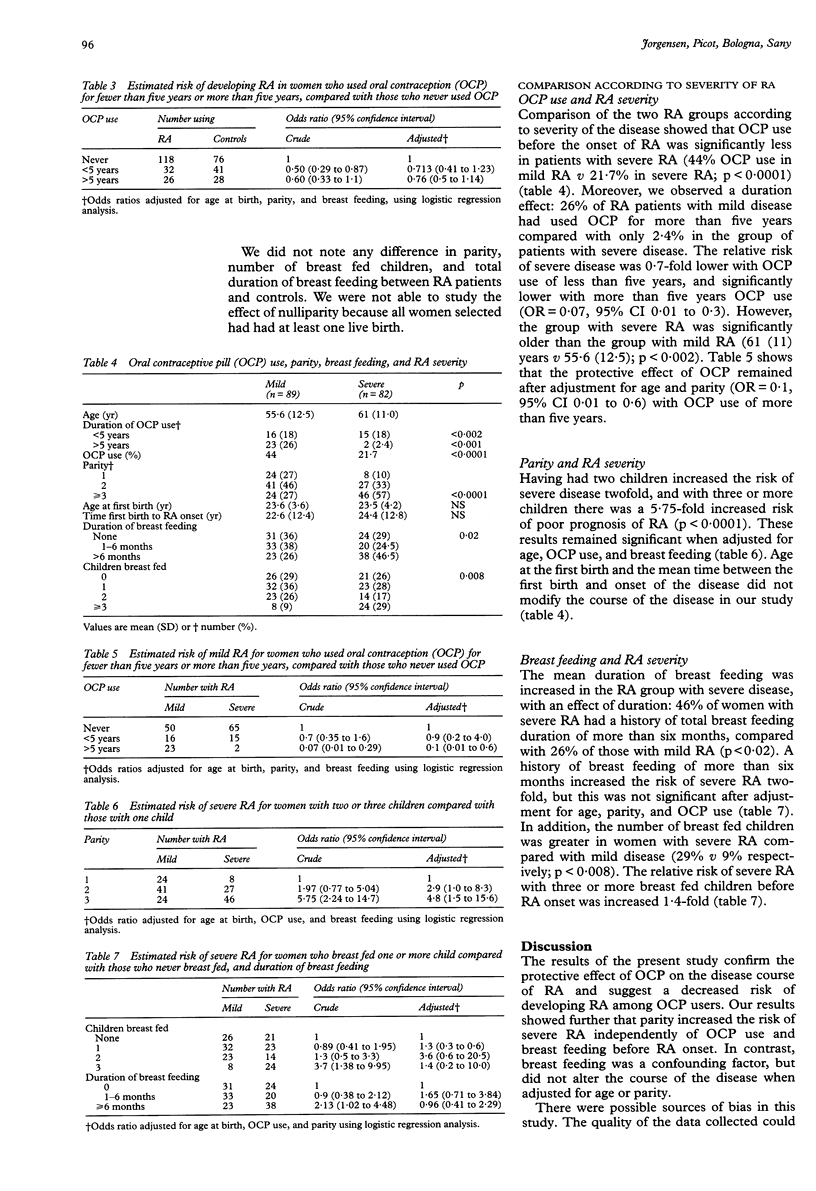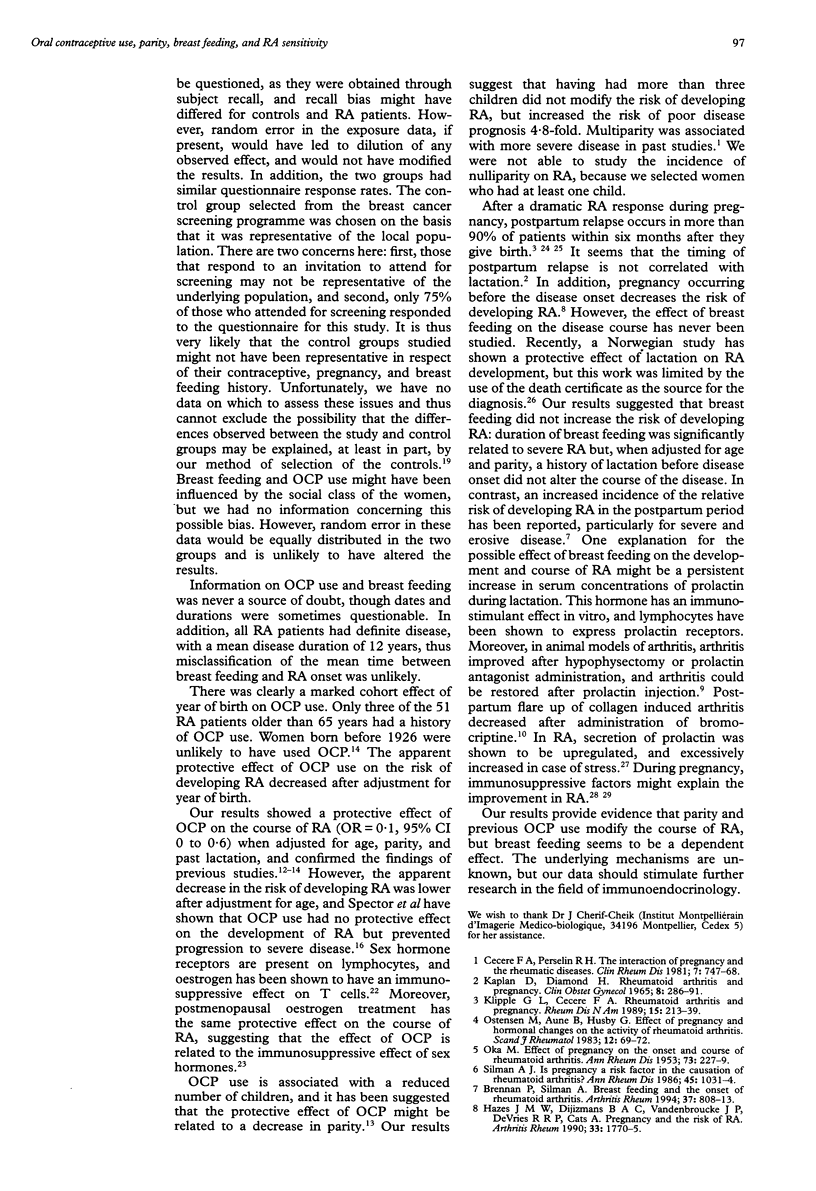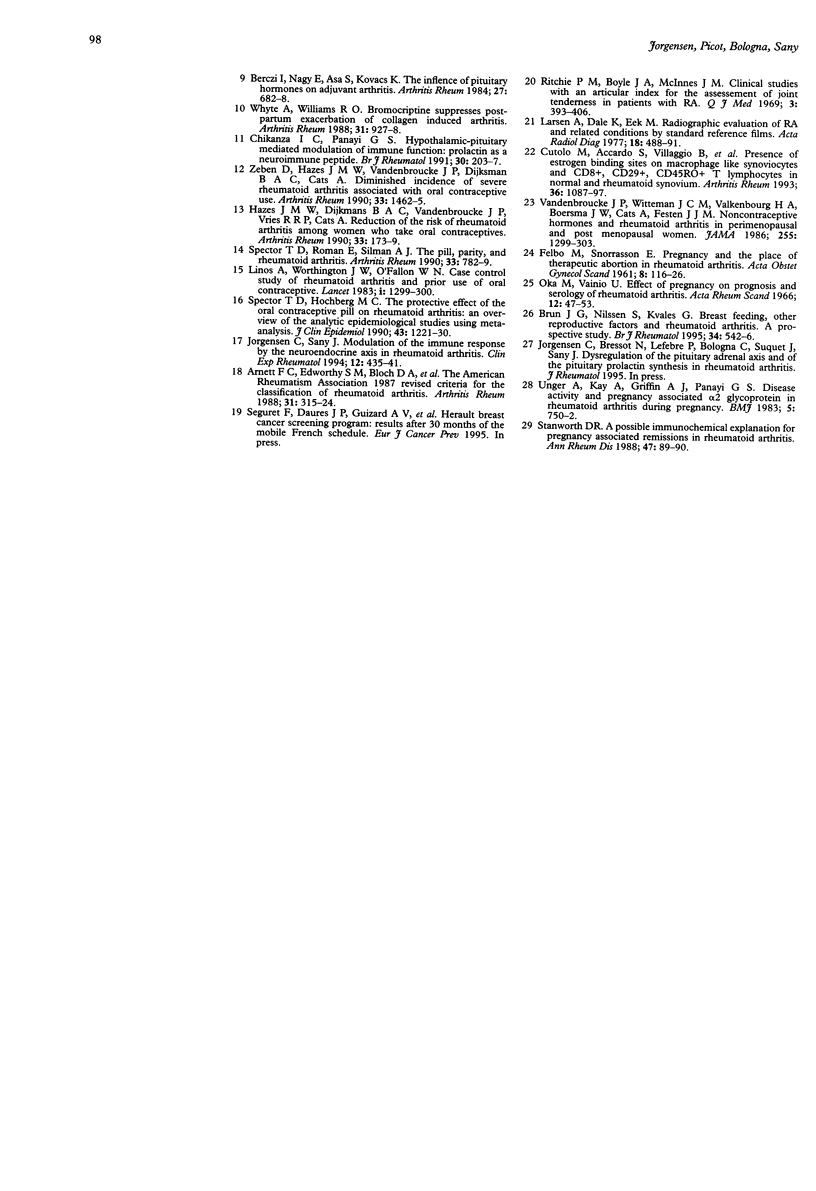Abstract
OBJECTIVE: To investigate the influence of breast feeding, use of the oral contraceptive pill (OCP), and parity on rheumatoid arthritis (RA). METHODS: One hundred and seventy six women with RA were compared with 145 control subjects; all had at least one child. RA patients were classified as having severe (n = 82) or mild disease (n = 89) according to clinical joint evaluation, radiological score, biological inflammation, and the presence of HLA-DR1 or -DR4 alleles. RESULTS: The mean age of RA patients was 58 years, and the mean age at the time of diagnosis of RA was 46 years. The mean time between onset of RA and the first birth was 23.6 (SD 3.8) years. The OCP user rates were 33% in the RA group and 47.6% in the control group (p < 0.02). OCP use was related to the mother's year of birth. The relative risk for developing RA was 0.598 (95% confidence interval (CI) 0.33 to 1.1) in women who had used OCP for more than five years compared with those who had never used OCPs. In contrast, the age at which the first pregnancy occurred, the number of children breast fed, and the duration of breast feeding were comparable in RA patients and healthy subjects. Among the RA patients, parity, duration of breast feeding, and the number of breast fed children were significantly increased in those with severe disease. Having more than three children increased the risk of developing severe disease 4.8-fold when adjusted for age and OCP use. Forty six percent of women with severe RA had a history of breast feeding duration greater than six months before disease onset, compared with 26% of patients with mild disease (p < 0.008). Having more than three breast fed children increased the risk of poor disease prognosis 3.7-fold. In contrast, OCP use had a protective role in the course of RA (44% of RA patients with mild disease were OCP users, compared with 21.7% of those with severe RA; p < 0.001). Among those using OCP for more than five years, the relative risk of developing severe disease was 0.1 (95% CI 0.01 to 0.6), after adjustment for age, parity, and breast feeding. CONCLUSION: Our results suggest that parity, and to a lesser extent breast feeding, before RA onset worsened RA prognosis, whereas OCP use had a protective role. Prolactin and oestrogen may have a role in these effects.
Full text
PDF




Selected References
These references are in PubMed. This may not be the complete list of references from this article.
- Arnett F. C., Edworthy S. M., Bloch D. A., McShane D. J., Fries J. F., Cooper N. S., Healey L. A., Kaplan S. R., Liang M. H., Luthra H. S. The American Rheumatism Association 1987 revised criteria for the classification of rheumatoid arthritis. Arthritis Rheum. 1988 Mar;31(3):315–324. doi: 10.1002/art.1780310302. [DOI] [PubMed] [Google Scholar]
- Berczi I., Nagy E., Asa S. L., Kovacs K. The influence of pituitary hormones on adjuvant arthritis. Arthritis Rheum. 1984 Jun;27(6):682–688. doi: 10.1002/art.1780270612. [DOI] [PubMed] [Google Scholar]
- Brennan P., Silman A. Breast-feeding and the onset of rheumatoid arthritis. Arthritis Rheum. 1994 Jun;37(6):808–813. doi: 10.1002/art.1780370605. [DOI] [PubMed] [Google Scholar]
- Brun J. G., Nilssen S., Kvåle G. Breast feeding, other reproductive factors and rheumatoid arthritis. A prospective study. Br J Rheumatol. 1995 Jun;34(6):542–546. doi: 10.1093/rheumatology/34.6.542. [DOI] [PubMed] [Google Scholar]
- Cutolo M., Accardo S., Villaggio B., Clerico P., Bagnasco M., Coviello D. A., Carruba G., lo Casto M., Castagnetta L. Presence of estrogen-binding sites on macrophage-like synoviocytes and CD8+, CD29+, CD45RO+ T lymphocytes in normal and rheumatoid synovium. Arthritis Rheum. 1993 Aug;36(8):1087–1097. doi: 10.1002/art.1780360809. [DOI] [PubMed] [Google Scholar]
- FELBO M., SNORRASON E. Pregnancy and the place of therapeutic abortion in rheumatoid arthritis. Acta Obstet Gynecol Scand. 1961;40:116–126. doi: 10.3109/00016346109157853. [DOI] [PubMed] [Google Scholar]
- Hazes J. M., Dijkmans B. A., Vandenbroucke J. P., de Vries R. R., Cats A. Pregnancy and the risk of developing rheumatoid arthritis. Arthritis Rheum. 1990 Dec;33(12):1770–1775. doi: 10.1002/art.1780331203. [DOI] [PubMed] [Google Scholar]
- Hazes J. M., Dijkmans B. C., Vandenbroucke J. P., de Vries R. R., Cats A. Reduction of the risk of rheumatoid arthritis among women who take oral contraceptives. Arthritis Rheum. 1990 Feb;33(2):173–179. doi: 10.1002/art.1780330204. [DOI] [PubMed] [Google Scholar]
- Jorgensen C., Sany J. Modulation of the immune response by the neuro-endocrine axis in rheumatoid arthritis. Clin Exp Rheumatol. 1994 Jul-Aug;12(4):435–441. [PubMed] [Google Scholar]
- KAPLAN D., DIAMOND H. RHEUMATOID ARTHRITIS AND PREGNANCY. Clin Obstet Gynecol. 1965 Jun;17:286–303. doi: 10.1097/00003081-196506000-00004. [DOI] [PubMed] [Google Scholar]
- Klipple G. L., Cecere F. A. Rheumatoid arthritis and pregnancy. Rheum Dis Clin North Am. 1989 May;15(2):213–239. [PubMed] [Google Scholar]
- Linos A., Worthington J. W., O'Fallon W. M., Kurland L. T. Case-control study of rheumatoid arthritis and prior use of oral contraceptives. Lancet. 1983 Jun 11;1(8337):1299–1300. doi: 10.1016/s0140-6736(83)92413-3. [DOI] [PubMed] [Google Scholar]
- OKA M. Effect of pregnancy on the onset and course of rheumatoid arthritis. Ann Rheum Dis. 1953 Sep;12(3):227–229. doi: 10.1136/ard.12.3.227. [DOI] [PMC free article] [PubMed] [Google Scholar]
- Ostensen M., Aune B., Husby G. Effect of pregnancy and hormonal changes on the activity of rheumatoid arthritis. Scand J Rheumatol. 1983;12(2):69–72. doi: 10.3109/03009748309102886. [DOI] [PubMed] [Google Scholar]
- Silman A. J. Is pregnancy a risk factor in the causation of rheumatoid arthritis? Ann Rheum Dis. 1986 Dec;45(12):1031–1034. doi: 10.1136/ard.45.12.1031. [DOI] [PMC free article] [PubMed] [Google Scholar]
- Spector T. D., Hochberg M. C. The protective effect of the oral contraceptive pill on rheumatoid arthritis: an overview of the analytic epidemiological studies using meta-analysis. J Clin Epidemiol. 1990;43(11):1221–1230. doi: 10.1016/0895-4356(90)90023-i. [DOI] [PubMed] [Google Scholar]
- Spector T. D., Roman E., Silman A. J. The pill, parity, and rheumatoid arthritis. Arthritis Rheum. 1990 Jun;33(6):782–789. doi: 10.1002/art.1780330604. [DOI] [PubMed] [Google Scholar]
- Stanworth D. R. A possible immunochemical explanation for pregnancy associated remissions in rheumatoid arthritis? Ann Rheum Dis. 1988 Feb;47(2):89–90. doi: 10.1136/ard.47.2.89. [DOI] [PMC free article] [PubMed] [Google Scholar]
- Vandenbroucke J. P., Witteman J. C., Valkenburg H. A., Boersma J. W., Cats A., Festen J. J., Hartman A. P., Huber-Bruning O., Rasker J. J., Weber J. Noncontraceptive hormones and rheumatoid arthritis in perimenopausal and postmenopausal women. JAMA. 1986 Mar 14;255(10):1299–1303. [PubMed] [Google Scholar]
- Whyte A., Williams R. O. Bromocriptine suppresses postpartum exacerbation of collagen-induced arthritis. Arthritis Rheum. 1988 Jul;31(7):927–928. doi: 10.1002/art.1780310717. [DOI] [PubMed] [Google Scholar]
- van Zeben D., Hazes J. M., Vandenbroucke J. P., Dijkmans B. A., Cats A. Diminished incidence of severe rheumatoid arthritis associated with oral contraceptive use. Arthritis Rheum. 1990 Oct;33(10):1462–1465. doi: 10.1002/art.1780331002. [DOI] [PubMed] [Google Scholar]


